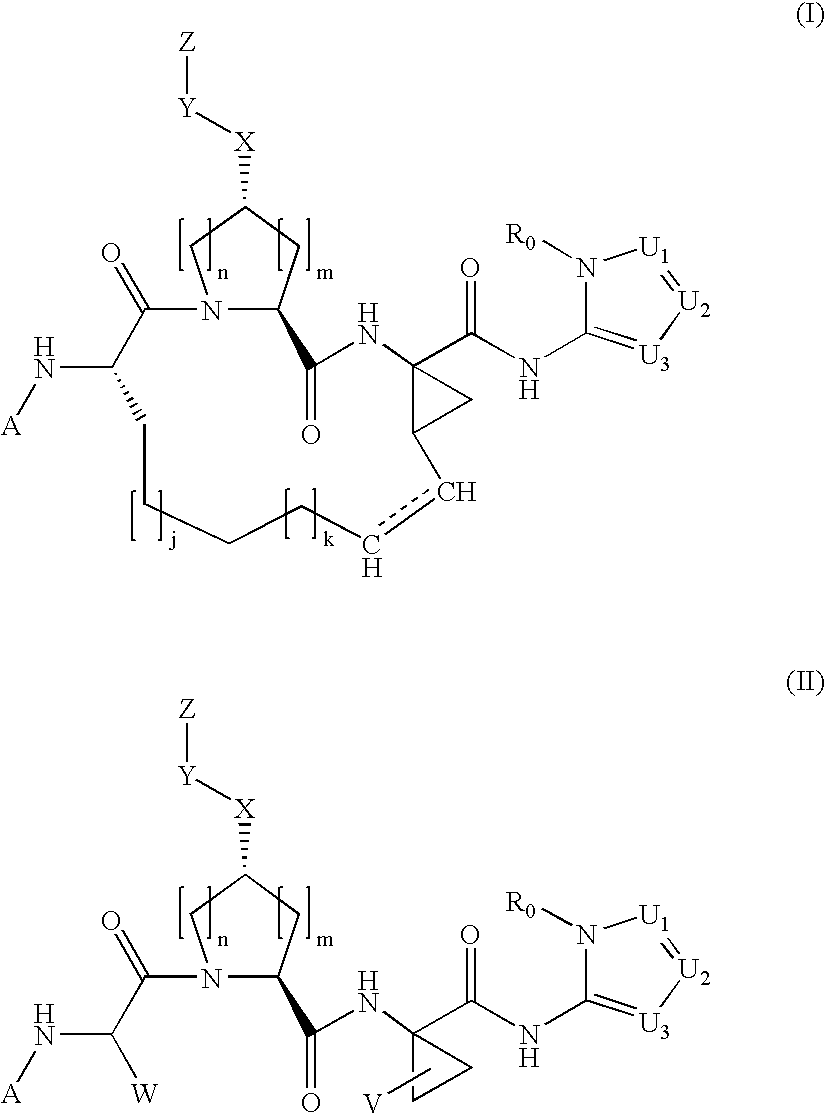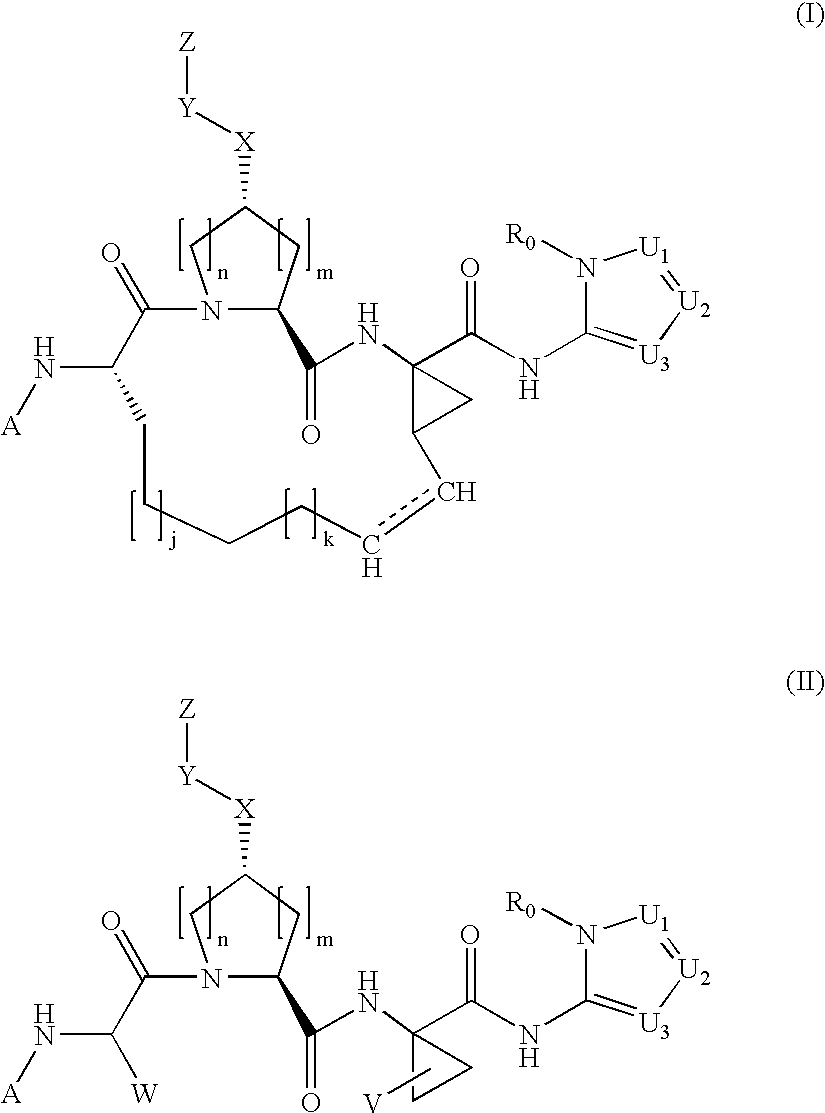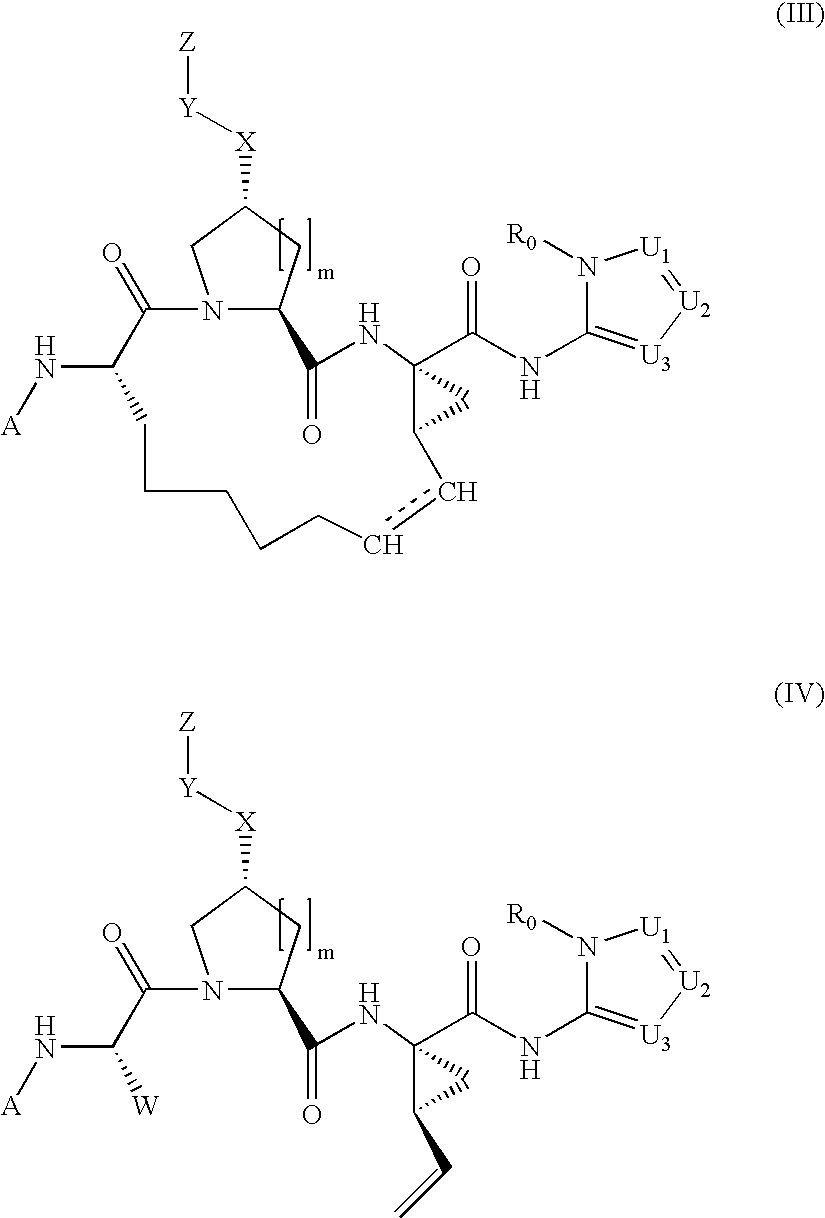Acylaminoheteroaryl hepatitis C virus protease inhibitors
a technology of acylaminoheteroaryl and hcv, which is applied in the direction of biocide, peptides, peptides/protein ingredients, etc., can solve the problems of interferon-related side effects, inability to reproduce infectious culture systems and small animal models of hcv, and increase public health problems, so as to inhibit serine protease activity
- Summary
- Abstract
- Description
- Claims
- Application Information
AI Technical Summary
Benefits of technology
Problems solved by technology
Method used
Image
Examples
example 1
Synthesis of the Cyclic Peptide Precursor
[0236]
[0237]1A. To a solution of Boc-L-2-amino-8-nonenoic acid 1a (1.36 g, 5 mol) and the commercially available cis-L-hydroxyproline methyl ester 1b (1.09 g, 6 mmol) in 15 ml DMF, DIEA (4 ml, 4 eq.) and HATU (4 g, 2 eq) were added. The coupling was carried out at 0° C. over a period of 1 hour. The reaction mixture was diluted with 100 mL EtOAc, and directly washed with 5% citric acid (2×20 ml), water (2×20 ml), 1M NaHCO3 (4×20 ml) and brine (2×10 ml). The organic phase was dried over anhydrous Na2SO4, filtered, and then concentrated in vacuo, affording the dipeptide 1c (1.91 g, 95.8%) that was identified by HPLC (Retention time=8.9 min, 30-70%, 90% B), and MS (found 421.37, M+Na+).
[0238]1B. Dipeptide 1c (1.91 g) was dissolved in 15 mL of dioxane and 15 mL of 1 N LiOH aqueous solution, and the resulting mixture was stirred at room temperature for 4 hours. The reaction mixture was acidified by 5% citric acid and extracted with 100 mL EtOAc. Th...
example 2
[0241]Compound of Formula XV, wherein
Step 2A.
[0242]
[0243]To a cooled mixture of macrocyclic precursor 1, 3-(thiophen-2-yl)-1H-quinoxalin-2-one 2a (1.1 equiv.), and triphenylphosphine (2 equiv.) in THF was added DIAD (2 equiv.) dropwise at 0° C. The resulting mixture was held at 0° C. for 15 min. before being warmed to room temperature. After 18 hours, the mixture was concentrated under vacuum and the residue was purified by chromatography eluting with 60% EtOAc in hexanes to give 2b as a clear oil (100 mg, 99%).
[0244]MS (found): 704.4 (M+H).
[0245]H1-NMR [CDCl3, δ (ppm)]: 8.6 (d, 1H), 8.0 (d, 1H), 7.8 (d, 1H), 7.6 (m, 2H), 7.5 (d, 2H), 7.2 (t, 1H), 7.0 (brs, 1H), 6.0 (brt, 1H), 5.5 (m, 1H), 5.3 (brd, 1H), 5.2 (t, 1H), 5.0 (m. 1H), 4.6 (brt, 1H), 4.1-4.3 (m, 3H), 3.1 (m, 1H), 5.3 (m, 1H), 2.1-2.3 (m, 2H), 1.3 (brs, 9H), 1.2 (t, 3H).
Step 2B. Amine Deprotection.
[0246]The title compound of Step 2A (82 mg, 0.116 mmol) was treated with HCl (4 M in dioxane, 3 mL, 12 mmol). The reaction mixt...
example 3
[0257]Compound of Formula XV, wherein
The title compound was prepared following the procedure described in Example 2 by starting with the corresponding Quinoline derivative in the Mitsunobu reaction.
[0258]MS (ESI) m / z 842.3 (M+H)+.
PUM
| Property | Measurement | Unit |
|---|---|---|
| mol % | aaaaa | aaaaa |
| temperature | aaaaa | aaaaa |
| pH | aaaaa | aaaaa |
Abstract
Description
Claims
Application Information
 Login to View More
Login to View More - R&D
- Intellectual Property
- Life Sciences
- Materials
- Tech Scout
- Unparalleled Data Quality
- Higher Quality Content
- 60% Fewer Hallucinations
Browse by: Latest US Patents, China's latest patents, Technical Efficacy Thesaurus, Application Domain, Technology Topic, Popular Technical Reports.
© 2025 PatSnap. All rights reserved.Legal|Privacy policy|Modern Slavery Act Transparency Statement|Sitemap|About US| Contact US: help@patsnap.com



